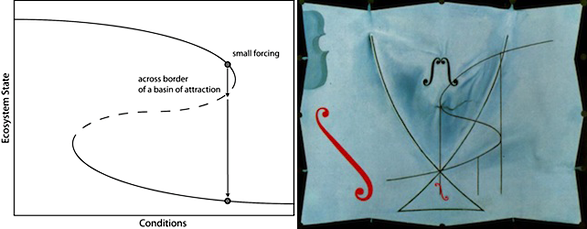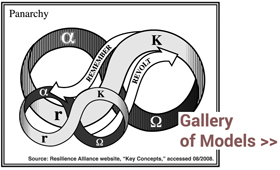“If one doesn’t have a concept of an object, one can’t recognize it,” insisted mathematician René Thom in To Predict is not to Explain, a set of interviews published in 1991 in French and 2010 in English.
Thom is generally credited with the terms attractor and basin of attraction, concepts that are fundamental to chaos, complexity, and resilience theory, and as I noted last time, are now used to map galactic superclusters.
Although Thom is little discussed these days, he was once widely celebrated. He received the 1958 Fields Medal and inspired both a 1976 film by Jean-Luc Godard and 1983 paintings by Salvador Dali, who portrayed Thom’s ideas about discontinuity, often called catastrophe theory, in his final works.
What happened to Thom and catastrophe theory? I’ve collected a few notes.
“[C]atastrophe theory was propelled on a wave of hype and enthusiasm during the mid-1970s only to die out in bitter controversies by the end off the decade,” wrote David Aubin in a chapter on Thom in 2004’s Growing Explanations: Historical Perspectives on Recent Science.
“[C]atastrophe theory did not live up to its promise of useful predictions,” asserted George Johnson in Thom’s 2002 NYT obituary.
Against such charges, Thom’s response was succinctly captured in the title, To Predict is not to Explain. As quoted in Aubin: “The ultimate aim of science is not to amass undifferentiated empirical data but to organise this data in a more or less formalised structure, which subsumes and explains it.”
As for his legacy, Thom wryly observed (in Predict ≠ Explain): “As a sociological phenomenon, the theory has foundered. Yet it’s a rather subtle sort of shipwreck, because all of the ideas which I’ve introduced have been incorporated into the language of common scientific discourse.”

The visual language of discontinuity is represented (1) on the left, in a figure I’ve redrawn from Marten Scheffer’s 2009 Critical Transitions in Nature and Society (p.267), describing “a disturbance pushing the system across the border of a basin of attraction,” and (2) on the right, in Dali’s The Swallow’s Tail, depicting what Thom called the swallowtail and cusp (low-resolution, fair-use image from Wikipedia, © Salvador Dalí, Fundació Gala-Salvador Dalí, Figueres).
Thom on metaphor (Predict ≠ Explain):
My critics said: ‘What you’re giving us is only a metaphor.’ How was I to interpret this, as a reproach or as a compliment? For my own part, I saw it as a compliment. To have created a metaphor in an area where previously there was nothing, that’s already progress! …
Analogies and metaphors, contrary to the popular opinion that considers them flexible or just approximations, impress me as exemplifying strict relations, ones which can, in many cases, be given exact mathematical expression.
___
To Predict is not to Explain, interviews by Emile Noël, translated by Roy Lisker, edited by S. Peter Tsatsanis, is currently available as a pdf at Roy Lisker’s website.
Regarding the origin of term attractor, Tsatsanis noted:
It is clear from his [Thom’s] 1990 unpublished article, ‘On attractors’, that the word ‘attractor’ was used by him in 1966. Thom says that Steven Smale [Stephen Smale] might have used it before then although Smale says it was Thom that coined the neologism ‘attractor’. The notion of a ‘strange attractor’ came later when chaotic systems were being studied.
For more on Dali’s The Swallow’s Tail, see the Gala–Salvador Dali Foundation, the Stockholm Resilience Centre, and an appreciation by Stephen Parker.

